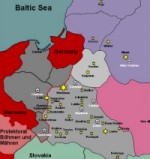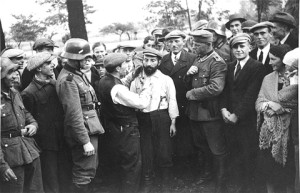 |
 |
 |
 |
 |
 |
 |
 |
 |
| Ghettos |
Tomaszow Maz. was occupied by German troops on 6 September 1939. At that time 13,000 Jews lived in the town. Very soon the Germans started tormenting and persecuting the Jews. Members of the intelligentsia were deported to KZ Buchenwald, others were forced to work in several camps in the Lublin district.
In December 1940 a ghetto was established, divided into three parts. All Jews of Tomaszow Maz. had to move into the ghetto, 3,000 Jews from neighbouring villages too. So 16,000 people had to share 250 houses, which means that 64 Jews had to stay in each house. Very soon a typhus epidemic broke out in January/February 1941.
On 15 December 1941 the ghetto was completely sealed off, the three parts put together. In January 1942 another typhus epidemic broke out. The ghetto population was decimated by epidemics, starvation, deportations to forced labour camps (Blizyn, Pionki), mass shootings and death sentences.
 |
| Jews, forced to shave their beards * |
On 29 October 1942, men, women and children proceeded to the building of the Judenrat, asking each other for the latest news. Above all, they wanted to know where they would be deported. People sought comfort by embracing one another, whispering words of parting, choking with emotion and ignorant of where they were going and what would be their fate.
In the evening the Gestapo appeared, ordering the Jewish police and the sanitary workers to calm down the crowd: "Everything would remain and none would be deported: but anyone spreading rumours about deportation would be severely punished". Everyone had to stay at home.
In the evening hundreds of Jews from the neighbouring towns and villages were already assembled, herded in a field, enclosed with barbed wire, waiting for the train to take them somewhere... From time to time shots were fired at the people, searching for their relatives. These shots too were a warning to anyone who even thought about escape. From early morning of 31 October 1942, most of the Jews had to enter the cattle cars, going to Treblinka. Jews of nearby villages arrived also and were added to the victims. Surplus people were sent back to the city, crammed into empty factory halls. Local Jews wanted to give them food and water, but were prevented from doing so by the Ukrainian SS men.
People rushed everywhere, trying to be reunited with their families. This one with a rucksack, that one carrying a bundle, mothers with children in their arms - and one holding several children by the hand. An order rang out: "Alle Juden Raus!" ("All Jews outside"). All Jews were expelled from their houses into the courtyards. There Jewish police, Gestapo and Ukrainians, armed with sub-machine guns, were waiting for them. The Jews were forced to throw down their rucksacks and bundles. They had to line up in rows of five, to form 20 or 25 rows, and to march towards the former hospital in Wajcznoso Street, leaving behind and stumbling over the dead and wounded. Husbands were torn from their wives, children cried, searching for their parents. The victims reached the hospital courtyard and lined up again in rows of five. In Wajsznoso Street an inspection took place. The Gestapo police men perused the documents permitting the Jews to remain in the ghetto for work. These Jews were sent back to a factory in Sotlerska Street.
All other Jews were divided into groups of 120 and sent to the railway station, guarded by armed Germans and Ukrainians. Before these 6,000 Jews were crammed into the waiting cattle wagons, their shoes, rucksacks and bundles were taken from them.
On 2 November 1942, the events were repeated with even greater cruelty and energy. Screaming like wild beasts and with murder in their eyes, the Germans began to root all the Jews from their houses into the winter morning cold. Old people, men, women and children were lined up in rows. Horrible was the sight of children of 4-5 years, separated from their parents, as they faced their murderers. Thus did Jewish children march to the hospital courtyard on their way to annihilation. Families began to arrive in rows of five. Among them were Reb Godel and his family, and Kalman Pinkusewicz and his family, apart from his eldest daughter Pesska, who remained behind in the townlet, as she held an authorized work permit. There was also R' Motel Neimitz and his family, apart from his son Moshe, who was a sanitary health worker. Rabbi Motel marched in the middle of the row.
All people, in batches of 100 or 120, were pushed into the wagons. Wagons without water and toilets for around 7,000 persons. The wagons were then bolted tight, a soldier sitting on the roof!
Around 900 Jewish manual workers remained in Tomaszow Maz., were they had to work in a labour camp of Organisation Todt in the town. On 29 May 1943, this camp was liquidated also. 650 survivors were deported to Blizyn labour camp, where most of them perished. 40 Jews had to clean the labour camp until September 1943. Then they were sent to Starachowice labour camp, fate unknown.
Around 200 Jews returned to Tomaszow Mazowiecki after the war. A Jewish community was not established again.
Sources:
Encyclopedia of the Holocaust
M. Grossman: "Deportation of the Jews of Tomaszow Mazowiecki in 1942"
Photo: USHMM *
© ARC (http://www.deathcamps.org) 2004